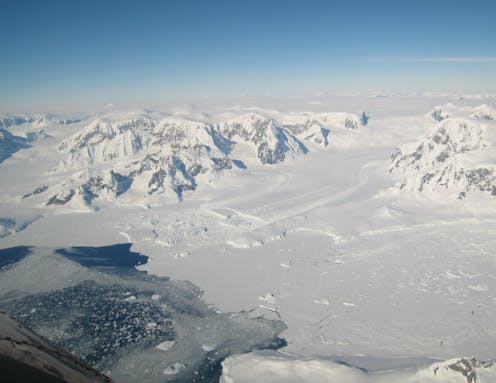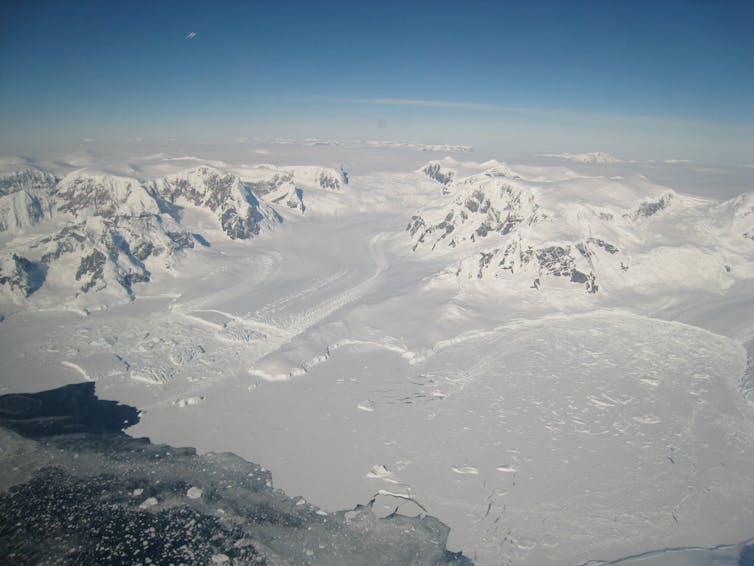
Pine Island glacier is one of the fastest flowing outlets of ice from the west Antarctic ice sheet, draining an area three-quarters the size of the UK. In recent decades, the glacier has been retreating rapidly and losing ice, contributing more to global sea level rise than any other Antarctic glacier.
The speed of the glacier’s retreat and the rate that is has been losing ice has led to concerns about how stable the region is. Model results show that this region of west Antarctica could collapse in the future. If it does, then it could raise global mean sea level by several metres.
There have been periods of rapid global sea-level rise in the past (by 1cm–2cm per year). This probably happened because glaciers were losing mass at an accelerated rate. One of the key mechanisms responsible for this is known as “marine ice sheet instability”.
When glaciers, like those in west Antarctica, experience a small retreat due to some change in the climate, they can continue retreating even if the change is reversed. Essentially, the glacier gets pushed beyond a tipping point, whereby it experiences rapid mass loss until it reaches a new state.
This kind of retreat is irreversible because the change in climate needed for the glacier to recover its original position is much greater than what initially caused it to retreat. This instability mechanism is well understood in theory, and models show it could happen in west Antarctica in the future. But until now there has been no proof that it had happened in the past.
In a new study, we found that Pine Island Glacier experienced irreversible mass loss and retreat, starting in the 1940s. Our model suggests that a temporary increase in melting under its floating ice shelf was enough to push the glacier past a tipping point.
This phase of accelerated retreat had finished by the 1990s. But, in a separate study where we used the same model, we found that the glacier will cross future tipping points unless global warming is kept within safe limits.

What happened?
Before the 1940s, Pine Island Glacier extended further than it does today. Its grounding line – the point at which glacial ice begins to float in the ocean rather than being in contact with the ground – was situated 40km further downstream on a shallow ridge on the seabed. This ridge provided a stable position for the glacier, keeping it in place, possibly for at least 5,000 to 10,000 years.
Recent observations show that ocean conditions beneath the floating ice shelf change from year to year. Every so often, warmer waters come into contact with the floating underside of the ice, causing a lot of melting from below. In the 1940s, a climate anomaly in west Antarctica, which has been linked to a large El Niño event, possibly triggered a temporary change in ocean conditions.
We found that an increase in melting due to changed ocean conditions beneath the ice shelf would have led to the thinning of its grounded ice further upstream. This caused a gap to open between the grounded glacier and seabed, allowing warmer ocean waters to flow beyond the ridge. These results are supported by evidence recovered from the sediments under the present-day ice shelf.
Once warmer waters circulate beneath the newly exposed ice, it triggers further melting and thinning, at an even faster rate. Our model shows that this sparked rapid retreat and accelerated ice flow over the following two to three decades, culminating with the detachment of the ice shelf from the ridge between the late 1970s and the early 1980s. The pattern and timescale of retreat shown in our model is consistent with observations of changes in the glacier.
Irreversible change
After the ice shelf detached from the ridge, there was a slowdown in ice flow and a more gradual retreat. This retreat only stopped when the grounding line reached a shallow section of bedrock in the early 1990s.
Our analysis shows that the phase of rapid retreat between the 1940s and 1970s was irreversible. If ocean conditions cooled and there was lower melting beneath the shelf during that period, then this would have been unable to stop the ongoing mass loss.
These results show us that if there is a significant increase in melting at the base of a glacier’s floating ice shelf, it can retreat past a tipping point. This means that even if conditions cool down, the loss of ice mass may be irreversible.
The future implications of this are clear. What occurred before could happen again. If we cross future ice sheet tipping points, simply reverting back to the previous climate conditions might not be enough to fix the damage.

Don’t have time to read about climate change as much as you’d like?
Get a weekly roundup in your inbox instead. Every Wednesday, The Conversation’s environment editor writes Imagine, a short email that goes a little deeper into just one climate issue. Join the 20,000+ readers who’ve subscribed so far.
Brad Reed receives funding from The Natural Environment Research Council and UK Research and Innovation.
Hilmar Gudmundsson receives funding from The Natural Environment Research Council, NSF and EU Horizon 2020 programme.
Mattias Green receives funding from The Natural Environment Research Coucil.
This article was originally published on The Conversation. Read the original article.







